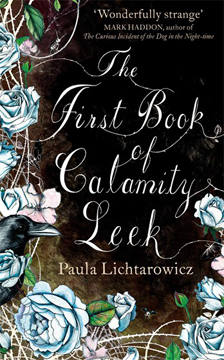Dogs good, children less so
by Paula LichtarowiczPaula Lichtarowicz’s debut novel The First Book of Calamity Leek is an inventive, macabre and fantastical story about a young girl who compiles her own guide to life on escaping her cruel confinement in a secret garden where she and other girls have been kept brainwashed and misinformed, and where popular musicals are a sinister presence. Here are her top ten tips for writers at any stage of their career.
1. Read
Whenever you can, as widely as you can. Let great writing sneak under your skin. Stop and marvel if you want, keep your senses open to daring construction and magical sleights of hand; read with envy and a nudge to your own ambition; but above all read for pleasure, don’t make it a chore.
2. Steal a dog
Or acquire one legally if you prefer. They are very useful for getting you outside walking. This may be the only thing to save you when you have tumbled light years down the black hole of writer’s block. Although please be careful not to follow the approach of Mrs V. Woolf and put stones in your pockets when you try this method.
3. Don’t have children
Or if you do, hand them over for a couple of hours of the day to someone qualified to detain and amuse. Possibly, if your name is J.M. Barrie and the dog is a Newfoundland called Nana, this could be linked to point two (see how useful dogs are?).
4. Build a high wall around the time you find to write
An hour works. Two is better. Three ideal. Steal this time from work, the family, your lover, the pub. Or steal it from sleep (easier, I grant you, in summer). But cement this wall and make it airtight to the world outside. A moat helps, into which electronic devices may be dropped. As does anti-climb paint. If you cannot find your way inside this time to write do not be kind to yourself. Do not make excuses. Tell yourself this: either you want to write or you don’t. Which is it?
5. Do this every day you are writing a draft
Even on a day when apocalypse has befallen the world at large and you can only enter the wall for fifteen minutes; do so. Think of the space inside the wall as a delicate ecosystem that requires your living, breathing, daily presence to thrive. Without you the organisms you are growing inside will shrivel and die.
6. Do not over-write
Inside the wall natural resources are finite and nothing gushes forever. Therefore pace yourself. Set a daily time limit or preferably a word count. And achieve it.
7. Be kind to yourself
When you write your draft do not stop to criticise. You must not stop to criticise. Keep the momentum and believe in your magic. Keep going day after day – forwards not backwards. There will be lots of time to criticise later. Remind yourself this is writing. This is what you love to do. It does not get better than this. On days you are struggling, remember consuming chocolate biscuits is also being kind to yourself.
8. Age your work
Not necessarily in a damp cellar; any quiet drawer will do. Let the draft lie, fat and heavy. A month is good. Two months is better. You could use your dog to guard it, if you like.
9. Be unkind to yourself
Only do this when you have rigorously followed points 5 to 8. Only do this when you are feeling robust and are excited about being back inside the wall. Take a critical pen to your draft. Know that inside the wall some crops must go for the finest to blossom. Be as harsh as you can be. And then begin again, being kind. As a Mr S. Beckett has it: No matter. Try again. Fail again. Fail better.
10. Most of all, remember truth is all there is
That is to say do not try to write for anyone else, or like anyone else, but keep your words true to your perception of the world. Which is unique. Remember also truth in fiction takes makes forms – from the kitchen sink to the restaurant at the end of the universe. All are valid. All are a means of connecting. Ask yourself, if you are not telling the story of the world as you see it to reach out to other people, what exactly are you doing?
 Paula Lichtarowicz lives in London and when she is not writing works in television production. The First Book of Calamity Leek is published in paperback and eBook by Windmill Books. Read more.
Paula Lichtarowicz lives in London and when she is not writing works in television production. The First Book of Calamity Leek is published in paperback and eBook by Windmill Books. Read more.
Author portrait © Paul Stuart


